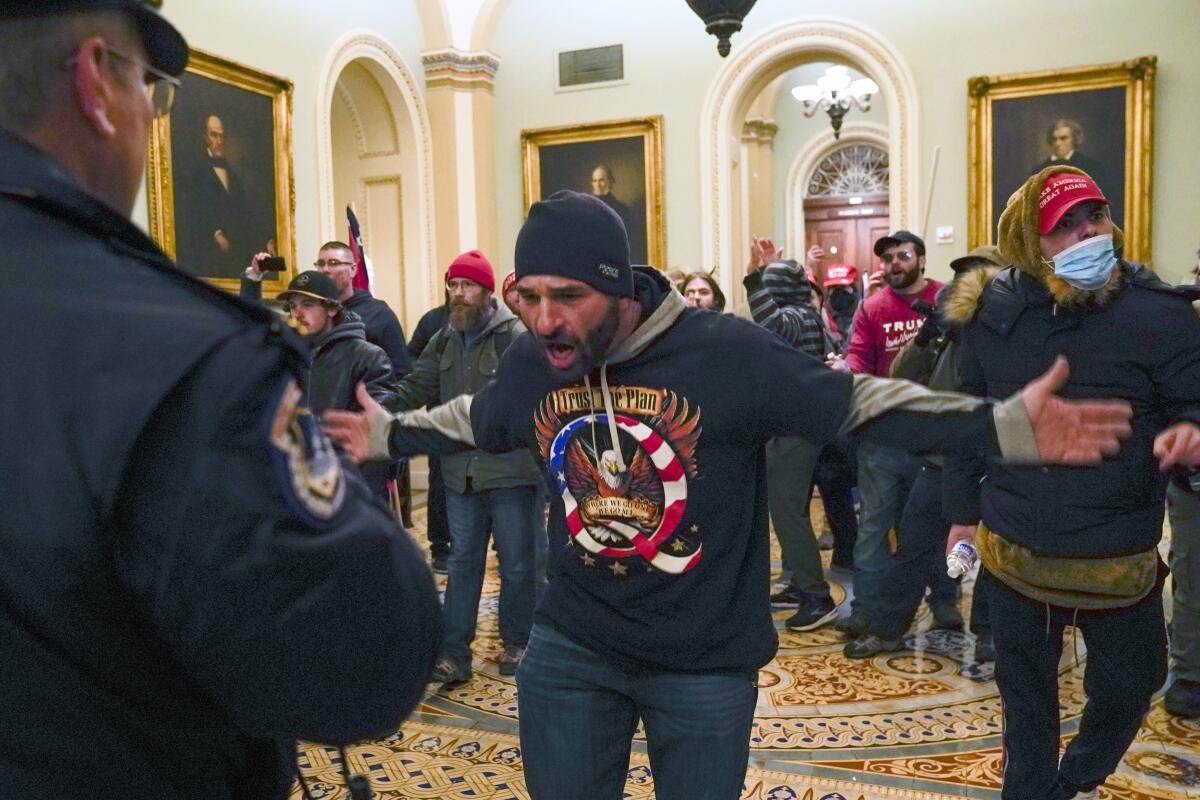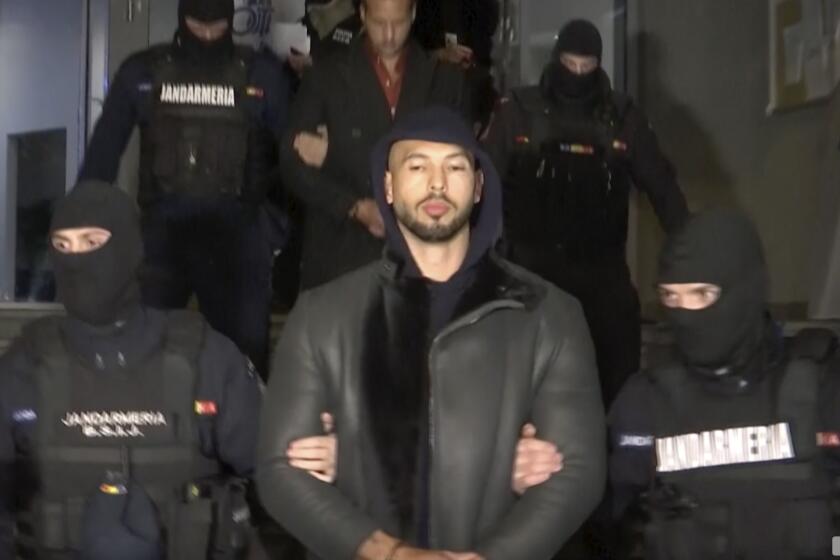Opinion: Why do so many young white men in America find fascism ‘cool’?

- Share via
Last fall, just blocks from my apartment in Cambridge, Mass., a gang of neo-Nazis gathered in Harvard Square on a Sunday afternoon. Videos showed a group of masked white men shouting, spitting, cursing homophobic slurs and chest-thumping at students. They were part of the Nationalist Social Club, a local neo-Nazi outfit, nicknamed the “131 Crew,” as if it were a sneaker collective and not a gang.
In researching the rise of the fascist movement in the United States, I have found troubling parallels to 1930s Italy and Germany. From cult worship and rising antisemitism to hatred of minorities and birthrate theories steeped in eugenics, the overlap between the Fascist ideas of the interwar years and our own are too stark to ignore.
Why is it that so many young white men, particularly of my generation, are turning to fascism and the far-right?
In recent years, toxic masculinity has become a booming industry — filled with ridiculous figures and ridiculous sales pitches — and a political movement.
A recent survey by the Anti-Defamation League found that 85% of Americans believe “at least one anti-Jewish trope,” a rise since 2019. Whether the 131 Crew, or Gavin McInnes, the VICE Media co-founder and Proud Boy founder, or even the nether reaches of QAnon, Andrew Tate-land and the message board 4chan: the angry, alienated male is finding fascism not just appealing, but cool.
In the case of McInnes, his Proud Boy affiliates are currently on trial in federal court for sedition, or trying to overthrow the U.S. government by force. McInnes hails from Ottawa, Canada, wears a slick mustache and glasses; when he’s been profiled in American newspapers, he looks like a hipster. “We don’t start fights,” McInnes has said, “but we will finish them.” Far-right influencers have won legions of followers on YouTube and other platforms and amassed hundreds of millions of views, tapping into an aggrieved male psyche that few other media reach. This is before even considering alternative forms of social media where the far-right gather. If we miss recognizing this fascist cult, it is because it exists in plain sight.
The word “fascism” is often thrown around loosely, and some may feel applying this label is overly dramatic. But its current manifestation in the U.S. mirrors its incarnation eras ago: an ideology that glorifies the traditional masculine, believes in a spiritual right to exact violence and calls for the seizure of government for authoritarian rule. The fascists are unified by their love of violence, their hatred of progress and their sinister sense of entitlement that declares that America belongs to them.
Fascism feeds off culture wars, exploits psychological insecurities and uses deeply held resentments to convert the impressionable. At a time of intense polarization and cultural battles over race, gender and democracy, it’s not surprising that fascism has found young adherents, this time as a lifestyle, with cosplay.
In Italy, Benito Mussolini, in the very first pages of his “The Doctrine of Fascism,” noted that Fascism is not merely political doctrine but “a spiritual attitude.” In Italy, as in the rest of Europe in the interwar years, Fascist parties won increasing shares of the vote, giving people not just a political cause to live for through the state but also carnivals, parades, fairs and other forms of social bonding. For tens of millions of Europeans, Fascism was fun. And for some years, it was seen as a legitimate alternative to liberal democracy.
The Fascists, then and now, placed unique emphasis on propaganda. Indeed, at a meeting of radio broadcasters in Berlin in 1933, Joseph Goebbels, the Nazi minister of propaganda, gave the state broadcasters some urgent advice: “The first law is don’t become boring!”
From the start, Fascism was focused on culture. Mussolini wanted a strong, masculine society reminiscent of the Roman Empire. Hitler was likewise entranced with the imagined past, and in the memoirs of Albert Speer, his chief architect, one finds Hitler examining architectural designs and building plans for hours on end. The buildings had to be neoclassical, they had to be strong, they had to be grotesquely gigantic. The Nazis took particular aim at “degenerate” and “Jewish” art — raiding the museums and galleries, destroying any hint of modernism.
An enormous amount of effort went into creating the aesthetics of Fascism in both Italy and Germany: the performances, carnivals, stage shows, youth rallies — all of it duly filmed, edited, put out to the public before social media. Hitler himself preferred the night marches with torches because they added an ominous, underworld sense to his movement. The pageantry and symbols were key tools in promoting the ideology.
Today’s fascists are malleable and take on different forms, some more racist than others, some more sexist. But they’re drawn to the propaganda and symbols of racial and sexual brutality. For many young white men, fascism starts as a cultural identity, rather than as a political ideology.
White replacement theory and its ideological predecessors have been central to fascist movements throughout history. It’s no surprise both are on the rise now.
Culture shapes thoughts that, if poisonous enough, will carry horrifying consequences. In the shooting at the Emanuel African Methodist Episcopal Church in Charleston, S.C., in 2015, the mass killer wore a jacket emblazoned with the flags of Rhodesia, a racist former British colony that became Zimbabwe and apartheid South Africa. The emblems of white supremacy and fascism were woven into his clothing. The 2019 mass murder of Muslims in New Zealand was livestreamed on social media. Last November, the murderer who killed five people at a gay nightclub in Colorado Springs ran a neo-Nazi website and used racial slurs while playing video games.
On the toxic sexism spectrum, Andrew Tate is the prime example of a propagandist who has won an audience of millions of men by feeding them an authoritarian, sexist ideology. A white nationalist influencer — who goes by the nickname “Baked Alaska” and loves both weed and assaulting Jews and people of color on the street — recently pleaded guilty for his involvement in the Jan. 6, 2021, insurrection.
The reach of these men has been exponentially expanded by algorithms and social media platforms, geared toward outrage and excitement. The Fascists of the 20th century could only dream of such easy propaganda tools. The fight ahead will not be easy. It will require a generation doing its best to push back against fascism and reinvigorate democracy, this time at home. The Nazis marching through Harvard Square are a reminder that fascism is here. We ignore it at our own peril.
Omer Aziz is a Radcliffe fellow at Harvard and author of the forthcoming memoir, “Brown Boy.”
More to Read
A cure for the common opinion
Get thought-provoking perspectives with our weekly newsletter.
You may occasionally receive promotional content from the Los Angeles Times.












